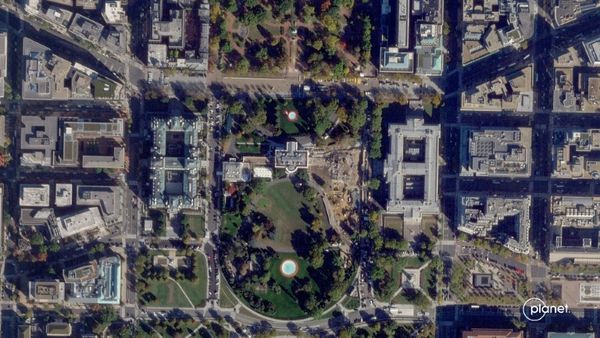Subscribe to The Y’all — a weekly dispatch about the people, places and policies defining Texas, produced by Texas Tribune journalists living in communities across the state.
TRINIDAD – It was a cold morning in February 2022 when Bud Morton drove his black 2015 Chevrolet truck down the last mile of Farm to Market Road 1667 to the same launch point he’d used to get to his favorite fishing spot for more than 20 years.
There, on a creek called the Cutoff, he’d gotten to know all the different types of fish and their spawning schedules. He spent years visiting with alligator gar swimming alongside his boat and spiders catching a ride as he navigated his way through the waterway’s boxcar culverts and under wooden bridges.
But this time, when he pulled up, he saw two 5-foot-high, red pipe fences blocking the water’s edge. Signs hung from the fences: “NO TRESPASSING.”
Frustrated and bewildered, Morton took his Jonny boat and left.
“I was definitely mad,” Morton said. “As the week or two after that went on, more fences were built and more dirt brought in.”
The end of that single-lane state road was the community’s last remaining public boat launch to access the small streams that meander through southwestern Henderson County.

It was Phillip Surls, a wealthy local businessman, who installed the fences after he bought the property along each side of FM 1667 in late 2021. He wanted to keep his cattle off the road, his attorney has said.
Surls, who declined to be interviewed for this article, has been repeatedly told to remove the fence by the state, and he’s been scolded for digging up the creek by Henderson County and the U.S. Army Corps of Engineers. He was fined by Texas Parks and Wildlife for killing thousands of mussels in doing this work.
But to no avail. Surls continues to argue that land surrounding the Cutoff is not public — that it belongs to him and he is well within his rights to restrict access.
His move to block his neighbors from the waterway has set off a series of legal battles over land and water public access issues that have played out for years.
In September, Surls scored a major victory when a district court ruled the Cutoff is not navigable, meaning it’s not a public waterway. And if it’s not a public waterway, then the public doesn’t need access to it.
The judge’s ruling was a blow to a group of community members who spent years fundraising to afford an attorney willing to take on this fight. Their resources barely covered a fifth of the legal fees they’ve accrued. But they plan to appeal the ruling.
Those locals, who formed a group called Save the Cutoff, say they’re being outgunned by someone with more money and political connections who took away their access to an important part of their community’s identity.
“What hurt my feelings the most? That was our little community paradise,” said Elden Reschke, a member of the group who can count the number of times he’s left East Texas on one hand. “And a rich man’s taking it away from us.”
The long fight to keep the Cutoff public
In the late 1800s, Dallas industrialists struggled to get boats up the Trinity River because its water levels were unreliable and often fraught with obstructions, like downed trees, or sharp turns that were hard to navigate. They advocated for major changes to the river’s geography. Over the course of decades, a new path for the Trinity was carved out, with the investment of millions of dollars and the installation of new levees.
Thus, the Cutoff was created — named because it was literally cut off from the Trinity River. And for the next century, locals would fight to keep it open to the public.
Today, the Cutoff is a 12-mile stream along the border of Henderson and Navarro counties. It starts at the Old Cedar Creek, and ends at Creslenn Ranch Lake. It runs through small wooded areas and ranch lands. Private lakes have formed along each side of the waterway.
In 1931, in a story that parallels Surls’, Adam Cone, a businessman from a nearby town, purchased land surrounding the Cutoff and tried to block the public from it. His actions prompted community outrage and resulted in the issue being taken up in a special session of that year’s Legislature.
Texas lawmakers passed a law that year, declaring the Cutoff public and demanding that Henderson County and the Texas Department of Transportation build roads so the community could continue to use it for fishing and hunting. However, that law was repealed in 1967, when the state consolidated several departments under one umbrella named Texas Parks and Wildlife.
In the 1950s, another local businessman, Clyde Alexander, established Creslenn Park, which was dozens of acres along the waterway with picnic tables, camping spots and docks. He promised the community it would be open to the public to reach the water for the next 50 years.
That park land is now owned by Surls.
But before it closed, it was a thriving community hot spot — a space to deep fry freshly caught catfish on the Fourth of July or cut a cake on birthdays.

Now, the picnic areas that were part of Creslenn Park have decayed. Skeletal remains of old boat docks stick out of the water.
Lee Nolan, 76, said he resents the fact that the community can’t use the park now as it once did, and that even fishing on the Cutoff has been taken away.
He said he grew up going to Cresslen Park. When he was a kid, he and his dad would go visit his great uncle who lived in one of the homes around the park where they’d play cards and dominos at the picnic tables.
As he grew older, he spent many evenings camping there with his friends. One night, the cries of a mountain lion frightened them so badly they hid in their sleeping bags, he recalled.
“It was a great place to grow up,” Nolan said. “Trinidad was a great town to grow up in. And Cresslen Park, or the Cutoff — as we affectionately called it — was entertainment for many, many years.”
Phillip Surls’ fight
Surls, 58, grew up in Henderson County and he still lives and runs a cattle operation and a construction company there.
In 2021, he bought large swathes of the land surrounding the Cutoff just before Christmas for his cattle operation. That land was valued at about $19 million this year.
Surls apparently intended to move his cattle from one side of the banks of the Old Cedar Creek to the other, according to a letter his attorney wrote to the U.S. Army Corp of Engineers. In February 2022, he started dredging, or digging up other areas of the creek, and laying large rocks. He extended a culvert and erected the fences to contain the cows. The letter from his attorney said the fences were simply replacing fences that were already there.
Morton said there was never a fence like what Surls installed. There was a fence on each side of the waterway, but it was not on the state right of way and did not block public access.

The county gave Surls permission to keep the fence, and Morton said for a while sheriff’s deputies would enforce trespassing violations for people who tried to cross.
But the following month in March, the Army Corps of Engineers sent Surls a cease and desist letter saying he had worked on federal waters without authorization from the corps. The letter says Surls violated the Clean Water Act when he put dirt and sand and other material along the state’s right of way. He stopped work.
Around the same time, the Texas Department of Transportation sent Surls a notice that he was obstructing the public right of way with the fence and he should remove it within 30 days.
A few months later, in September of that year, TxDOT sent Surls a second letter, again telling him to remove the fence.
The fence is still there.
Asked why TxDOT has taken no steps to remove it, an official said they’re waiting for legal matters to be resolved.
“While the fence was within the state’s right of way, we held off on removing it due to ongoing legal matters, including a cease-and-desist order from the Corps of Engineers,” Jeff Williford, the TxDOT Tyler District Public Information Officer, said. Though in TxDOT’s letter to Surls, they said their order does not violate the Corps’ cease and desist.
Around the same time, Surls took a new interest in Texas politics — shoveling out $23,900 on state candidates in November and December of that year.
Prior to this, he’d donated a total of $350 to federal and state political groups over more than 10 years.
The largest donations were made to Texas Attorney General Ken Paxton — who Surls gave $10,000 to on Nov. 7 — one day before he won reelection. He also gave Dawn Buckingham $5,000 on Dec. 8, a month after her election to lead the General Land Office.
The General Land Office in 2010 issued an opinion stating that the waters of the Cutoff are public. But the agency hasn’t waded into this current issue.
The Texas Attorney General’s Office has the authority to sue the landowner on behalf of the state agencies.
TxDOT referred Surls case to Paxton’s office for legal action. But the attorney general’s office never filed suit. A spokesperson for the attorney general’s office suggested TxDOT changed its mind.
“It is not uncommon for a state entity to make a referral and have our office prepare a potential action, but then the referring agency requests that the office take a different course of action than what the referral initially requested,” a spokesperson for the Office of the Attorney General said in an email.
By the end of 2022, locals were disheartened by a seeming lack of action by government officials. They created the nonprofit, Save the Cutoff, and took their case to court.
Save the Cutoff sued Henderson County in January 2023 for abandoning a county road that had once served as another access point to the Cutoff that is now being used as a private road. They lost and are appealing to the Supreme Court.
Then, the nonprofit sued Surls in federal court that March for violating the Clean Water Act by discharging materials into the waterway. They cited the Army Corps of Engineers letter. Surls’ attorneys argued the work was complete, so he was not actively violating the law, which meant Save the Cutoff had no legal standing to sue. The federal judge agreed with Surls a year later, and the suit was dismissed.
The group also sued Surls in district court in August 2023, asking the court to declare the Cutoff public and demand Surls remove his fences. Last month, the judge sided with Surls.
On Nov. 17, 2023, after more than a year of investigating the impacts of digging up material and adding it to the right of way, Texas Parks and Wildlife fined Surls’ company $307,895.70 for killing nearly 7,500 mussels. That fine had not been paid as of mid-September 2025, according to the agency.
What’s next for the Cutoff
This year, more officials started siding with Surls over the community.
“You got to road the dead ends into private property,” said state Sen. Robert Nichols, R-Jacksonville. “Taxpayers are paying to maintain that thing… There’s the question of, are we willing to have taxpayer dollars continue to fund that?”
Nichols said Creslenn Park isn’t worth saving, adding that he thought it had turned into a hangout for drug users and homeless people before it closed. While he said he still considers the Cutoff public, he said there is no reason for the community to use private property to access it.

Several community members refuted Nichols’ analysis of what that area was.
“It was never, ever a mess,” said John Shumate, a former mayor of Malakoff and longtime Henderson County resident. “Even when I was going down there in my older years it was well kept.”
In February 2025, Nichols and state Reps. Cody Harris and Keith Bell authored a letter to TxDOT proposing the agency give Surls the last mile and a quarter of FM 1667. This would eliminate any requirement that the agency sue Surls.
And last month, TxDOT asked Henderson County if it would consider accepting the road as part of its system. The county commissioners, in a 3-2 vote, approved a letter expressing interest in taking over FM 1667 on Sept. 30.
This gave the county a seat at the table to decide what will happen to FM 1667 if TxDOT abandons it, Clint Davis, the county attorney, told The Texas Tribune.
“It is very clear that this action in no way obligates the County to take responsibility for the road or to become responsible for it at a later date,” he said.
Some worry the commissioners, some of whom have sided with Surls on this matter, would just let him have it.
Toward the end of August, the Army Corps of Engineers was nearing the conclusion of its investigation into whether Surls work violated the Clean Water Act and what the remedy would be, according to Neil Lebsock, an investigator. Surls’ legal team asked the Army Corps of Engineers to determine whether the Cutoff is actually waters of the U.S. under the new definition handed down by the U.S. Supreme Court in 2023.
Lebsock will have to spend the next few weeks determining whether the Cutoff connects to the Trinity River in any way, which would make it waters of the U.S. If Lebsock determines the Cutoff is not waters of the U.S., then he has no authority to go after Surls for violating the Clean Water Act.
“It’s a significant decision, if we were to make that,” Lebsock said.
This case is more than just about a public fishing spot, locals say. They worry it could open the door for private landowners to restrict access to public waters as long as they have enough money to fight the legal battles.
Nolan decided it was time to revisit his old haunt on Tuesday. He drove out to the end of FM 1667 with his daughter and watched trucks move in and out of Surls’ property. At this point, he hadn’t yet entered the fight, but he grew angrier as he thought about how unfair the situation was.
“Perhaps we can get it going well enough that we can fight this thing all the way to the Texas Supreme Court,” Nolan said. “It’s such a travesty to have a part of Trinidad’s history being abused and abruptly changed.”

Disclosure: Chevrolet and Texas Parks And Wildlife Department have been financial supporters of The Texas Tribune, a nonprofit, nonpartisan news organization that is funded in part by donations from members, foundations and corporate sponsors. Financial supporters play no role in the Tribune’s journalism. Find a complete list of them here.







